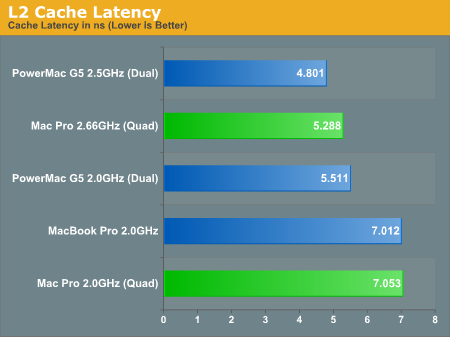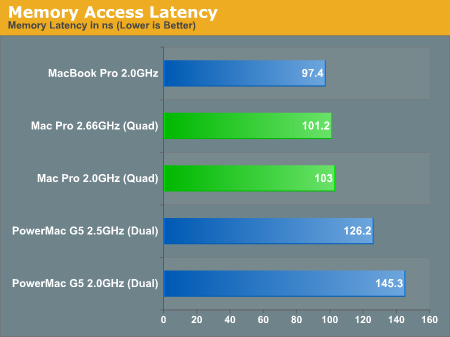Apple's Mac Pro - A True PowerMac Successor
by Anand Lal Shimpi on August 16, 2006 12:27 PM EST- Posted in
- Mac
Memory Performance
We'll start off our look at the Mac Pro's performance with some low level memory tests, since arguably the most controversial aspect of the Mac Pro is its use of Fully Buffered DIMMs. For more information about FB-DIMMs be sure to read our original article on the Mac Pro.

The G5 had a very quick 12-cycle L2 cache, which gives it a slight performance advantage compared to the 14-cycle L2 of the Xeons in the Mac Pro. Access latency is only one part of the puzzle however, as the G5s benchmarked here only had a 512KB L2 cache (the G5 later got an upgrade to a 1MB cache) while the Xeons in the Mac Pro have a 4MB L2 cache per chip. The G5 had a slightly faster L2, but you can reach higher clocks with the Xeon thus minimizing the effective latency and you can fit more data into the larger L2.

And here we see the real killer with FB-DIMMs; although the Mac Pro boasts lower latency memory accesses than the PowerMac G5, it actually takes longer to access main memory than the Core Duo processor in the MacBook Pro. This is much worse than it sounds once you take into account the fact that the MacBook Pro features a 667MHz FSB compared to the 1333MHz FSB (per chip) used in the Mac Pro.
We can further put things in perspective by looking at memory latency under Windows XP, compared to Intel's Core 2 processor. Remember that the Core 2 is identical to the Xeons in the Mac Pro, the difference being that the chipset uses regular DDR2 memory instead of DDR2-667 FB-DIMMs. Note that for our Core 2 system in the comparison below we ran the memory at DDR2-667 at 5-5-5-15 timings as well as DDR2-800 at 4-4-4-12 to provide apples-to-apples as well as apples-to-fastest comparisons.
| CPU | Everest |
CPU-Z 1.35 (8192KB, 256-byte stride) | Everest READ | Everest WRITE |
| Apple Mac Pro 2.66GHz (DDR2-667 FB-DIMM Quad Channel) | 100 ns | 87.4 ns | 4292 MB/s | 3759 MB/s |
| Apple Mac Pro 2.66GHz (DDR2-667 FB-DIMM Dual Channel) | 105.8 ns | 92.3 ns | 4141 MB/s | 3096 MB/s |
| Intel Core 2 Duo E6700 2.66GHz (DDR2-800 4-4-4-12 Dual Channel) | 59.9 ns | 52.8 ns | 7413 MB/s | 4859 MB/s |
| Intel Core 2 Duo E6700 2.66GHz (DDR2-667 5-5-5-15 Dual Channel) | 68.9 ns | 59 ns | 6782 MB/s | 4858 MB/s |
It's not Apple's fault, but FB-DIMMs absolutely kill memory latency; even running in quad channel mode, the FB-DIMM equipped Mac Pro takes 45% more time to access memory than our DDR2 equipped test bed at the same memory frequency. Things don't get any prettier when we look at memory bandwidth either.
Remember the overhead we were worried about with the serialization of parallel memory requests? With four FBD channels, the best we're able to see out of the Mac Pro is 4.292GB/s, compared to the 6.782GB/s of bandwidth our dual channel Core 2 testbed is able to provide. The efficiency table below says it all:
| CPU | Peak Theoretical Bandwidth |
Everest READ | Efficiency |
| Apple Mac Pro 2.66GHz (DDR2-667 FB-DIMM Quad Channel) | 21.3GB/s | 4.292GB/s | 20% |
| Apple Mac Pro 2.66GHz (DDR2-667 FB-DIMM Dual Channel) | 10.67GB/s | 4.141GB/s | 38.8% |
| Intel Core 2 Duo E6700 2.66GHz (DDR2-800 4-4-4-12 Dual Channel) | 12.8GB/s | 7.413GB/s | 57.9% |
| Intel Core 2 Duo E6700 2.66GHz (DDR2-667 5-5-5-15 Dual Channel) | 10.67GB/s | 6.782GB/s | 63.6% |
FB-DIMMs are simply not good for memory performance; the added capacity allowed by having 8 FB-DIMM slots on the Mac Pro had better be worth it, because if Apple were to release a Core 2 based Mac chances are that it could give the Mac Pro a run for its money in a number of memory sensitive tasks.










96 Comments
View All Comments
michael2k - Wednesday, August 16, 2006 - link
1:) Well, according to Anandtech's calculations, it's cheaper to buy a quad CPU Mac than to build one.2:) iLife is better than "free crap"
3:) Macs can run Windows, BSD, Linux, and OS X all at once; PCs cannot
4:) Drive sleds
5:) Ram risers
6:) Quiet case
7:) 6 SATA connectors
8:) 4 PCIe slots and 8 monitors
retrospooty - Thursday, August 17, 2006 - link
Yes, in general, good quality components cost more than cheap crap... This is why Acura and Lexus cost more than a Ford, even though they are all built in hte USA. Would you rather get the mobo, memory, HDD, and video card that some kind and caring (cough cough) company landed a mulimillion dollar cotract to buy 10's of thousands, or pick your own?What is your point?
nexcom - Saturday, November 28, 2009 - link
yes good and quality also mater aswell ok.michael2k - Thursday, August 17, 2006 - link
My point was that you got better build quality than the average DIY case:You get HDD sleds, cablefree installation, 2 gigE ports, 6 SATA connectors, etc, etc, etc.
Not everyone has the skill, time, or resources to do their own research, shopping around, and haggling, you know.
Are you arguing against, similarly, mass produced cars, TVs, homes, fridges, and furniture over DIY solutions?
Or do you shop at Target and Walmart too?
retrospooty - Thursday, August 17, 2006 - link
MAybe I am dense, but I am still missing your point... Anyhow, Apple's MAC's, or Dell, or any other vendor for that matter are not of high quality parts. The CPU's are great, most of the rest is cheap deal based components. Yes, most people lack the knowledge to build thier own systems, and they buy Dell's, and MAC's and such. All I am saying is that those systems arent at all using all the best high quality/high performance parts.michael2k - Thursday, August 17, 2006 - link
So I'm asking if you are consistent.Do you refuse to buy at Walmart and Target because they sell mass produced furniture, clothing, and household goods because they don't happen to use the highest quality materials? Do you, instead, build your own furniture, make your own clothes, grow your own produce, and make your own electronics?
I don't see your point, because you haven't proven it, that Macs use "cheap deal based components". The case is definitely not "cheap deal based components" because it is crafted of aluminum ONLY for Apple, and it is quite nonstandard compared to the average PC case. Then there is the Mac motherboard, which as far as I can tell is also unique, being a Xeon EFI based motherboard, crafted singularly for Apple, most likely by Intel itself. The video card, yes, it is cheap, but that saves the user money too, and is no worse than an off the shelf NVIDIA video card.
Where is your proof that the Mac Pro has cheap, unreliable, components?
retrospooty - Friday, August 18, 2006 - link
you're wearing me out... I give. Long live the MAC, may Apple break thier 10 year rut and finally get more than 3% global marketshare, maybe even 5%. Whoopdeedoo. Yippee skip.BTW, Apple's beautiful aluminum cases are a total ripoff (if not an out right purchase)of the Lian Li design. EFI is an average/cheap mobo maker at best (not to say unreliable, just average in function, and performance). They are no DFI, or ASUS, not even close.
Maury Markowitz - Friday, August 18, 2006 - link
You really are trolling...> total ripoff of the Lian Li
Well I've actually used one of these, which I really doubt you can claim, and they're certainly nothing at all like the Apple case. Or are you overheating those two brain cells because both cases happen to use aluminum? I guess, by that brilliant logic, that Apple stole the design of their cases from the Dornier Dr.I from World War I. After all, that used aluminum too.
For the record, the Lian Li design doesn't show a single one of the features that the Apple industrial design team put into the Mac Pro. They are, quite simply, bog-standard PC cases made of aluminum instead of stamped steel. That's it. For instance, the drives slide in from the front through a removable panel, are fastened into place with tiny little screws, and connected to the mobo with cables. Does this sound like the Mac Pro in any way whatsoever? Well pictures are worth a thousand words:
http://silverpcs.com/product_info.php?products_id=...">http://silverpcs.com/product_info.php?products_id=...
> EFI is an average/cheap mobo maker
Stop! Please, stop! My ribs are aching!
Hey brainiac, EFI is not a company.
> They are no DFI, or ASUS, not even close.
I hope not, considering it's an acronym for a boot standard.
If this is the basis of your "Apple is cheap" argument, you really are a moron.
Maury
retrospooty - Friday, August 18, 2006 - link
Sorry to all, my bad, I read too quickly and I thought the post above was stating that EFI (the company) made Apple's new mobo's.Anyhow, I was not saying they are particularily bad, or cheap, I was saying ALL manufacturers use "average" parts in thier systems, including Apple. Aplle may well be at or very near the best of the list of major manufactureres, but its still not like hand picking your own motherboard, ram, v card, HDD etc. In other words, if Apple was an open standard, and any manufacturer could make parts for it, you would see alot of higher quality parts from some of those vendors.
Any Yes, the case appearance is a TOTAL ripoff of Lian Li. The interior is certianly not, bute the look and feel externally, is identical, right down to the holes.
Anyhow, I am done on this one, I have riled up enough MAC fanboy anger for now :D LONG LICE MAC, may their marketshare double to a whopping 6% !
michael2k - Friday, August 18, 2006 - link
Right, a total ripoff... you sound like a broken record. Look at Anand's review here:http://www.anandtech.com/showdoc.aspx?i=2040&p...">http://www.anandtech.com/showdoc.aspx?i=2040&p...
It was introduced in April of 2004... almost a full year after Apple introduced their PowerMac G5 in June of 2003. The case design, with the cooling zones, grill face, and inverted motherboard all debuted in an Apple design and then was copied by Lian Li. This has nothing to do with being a fanboy and everything to do with being right.
You believe Apple ripped off the Lian Li... fine, link the Lian Li that preceeded the PowerMac G5 case!